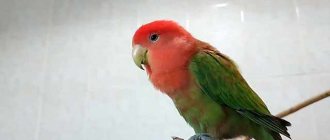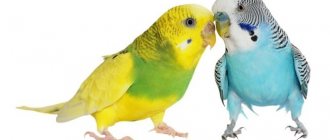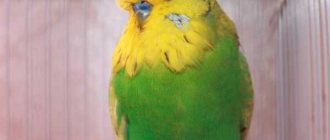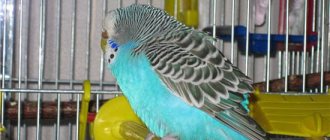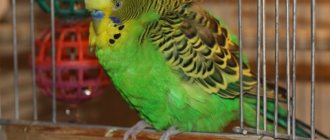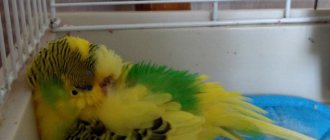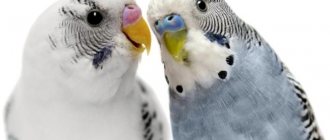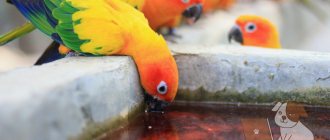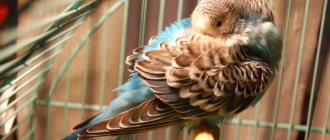A parrot's beak is a unique indicator of health: by its condition one can judge the presence or absence of a disease. The beak serves as the beginning of the digestive system, on which the functioning of all organs in one way or another depends. The article provides a description of possible problems: deformation of the horny plates, delamination, softening, rapid growth and other pathologies.
The structure of a parrot's beak
The beak is an organ made of keratoid tissue that replaces jaws and teeth in birds. Inside the shell there is a bone outgrowth. The oral apparatus of parrots is similar, with the exception of small nuances: size, color of the cere, location of the nasal passages. The organ consists of an upper and lower part, a tendon and a cere with nostrils. Normally, a budgerigar's beak does not peel off. The surface is smooth and shiny. Slight layering is allowed on the sides of the horny structure.
Purpose of the beak:
- capturing and grinding food;
- touch;
- participation in movement;
- communication;
- feeding chicks;
- protection.
A healthy beak is necessary for the normal functioning of birds, but if it peels and cracks, this is not a pathology. The stratum corneum is constantly renewed: it wears off and grows. But if there are obvious signs of a pet’s poor health, it’s worth thinking about why the parrot’s beak is peeling off and growths are forming. This may be the result of some kind of illness, malnutrition, or injury.
Regenerating properties
A broken organ can be fully restored if there is no damage to the line in the growth plate area. When a parrot's lower beak is broken in the middle, there is a high chance of regeneration. Adjusting the growing part with a file will help return it to its previous shape.
The regrowth process takes a long time. The main danger of the condition is the inability to eat normally. If your pet is unable to adjust its feeding process on its own, you should seek medical help. Clinic specialists reconstruct the beak using dental materials.
The prosthesis must be replaced or corrected as it grows. The excess is carefully cut off. In situations where it is impossible to perform prosthetics, you will need to feed your pet softer food yourself. It is also necessary to use vitamin complexes that replenish the lack of substances for regeneration in the parrot’s body.
It is recommended to supplement the bird’s diet with biotin, vitamin A, ascorbic acid, and folic acid. The development of secondary infections requires bacteriological studies of secretions from sites of inflammation. Antibiotic therapy is provided if necessary.
It is important to provide proper care for your pet. In case of fragility of the stratum corneum or diseases, provide timely and adequate therapy. Injuries and beak fractures with proper treatment and care have a positive prognosis and can be restored.
The beak of a budgerigar is an integral part of the bird's body. The importance of this organ cannot be assessed, because it plays a huge role in the life of birds. It all starts with the digestive function, because using its beak, the bird pecks food and feeds its offspring. In addition, the beak is needed for caring for plumage, building nests and defending its territory in the wild.
The beak is also of considerable importance in the processes of orientation in space, because the organs of touch are located along the edges and in the cavity of the beak. Living in the natural environment of the wild, birds that have abnormalities in growth or beak pathology are simply doomed to a quick death.
Many poultry keepers have no idea that a parrot can carry beak diseases, since this problem is quite common in our time.
Delamination
The beak is a protein structure; Minerals participate in its formation: calcium, zinc, phosphorus. With their deficiency and vitamin deficiency, first of all, the beak changes in appearance. It delaminates and becomes covered with small cracks. Beginners in poultry farming and those who feed their pets only grain often encounter separation.
You can fix the problem by revising your diet. The bird should be given a vitamin complex and sprouted wheat. Don't forget about sepia - a source of minerals. For prevention, eggshell powder, feed yeast, and a little honey are suitable.
Attention! Minor lamination occurs during the molting season. It is quite simple to correct: you need to ensure that there are always branches and stones in the cage for natural sharpening of the beak.
Deformations
Although the beak is very hard and firmly attached, it can become deformed. There is a congenital malformation when a chick is born with an irregularly shaped horn. Most often, such birds do not survive because they do not adapt to grab food. The problem may go away over time if the top and bottom parts close together, otherwise the pet will need special care for the rest of its life.
If a parrot's beak becomes bent at an early age, when the keratoid membrane is pliable, things can still change. When the growth zone is affected, irreversible complications arise. With curved, intersecting halves, shape correction is possible. It is important to see the deformation in time and help the pet. Inexperienced owners do not immediately notice that the parrot’s beak has become crooked. The cause may be an adult bird colliding with an obstacle, for example, hitting glass.
First aid
The beak of an exotic pet, despite its apparent strength, is vulnerable and often susceptible to damage. Heavy bleeding may occur in the area of the fracture due to a violation of the integrity of a large vessel. The bird needs emergency help.
If the parrot breaks the tip of its beak, it should be treated with hemostatic agents and medications. The use of alcohol-based formulations is strictly prohibited. It is optimal to use regular hydrogen peroxide and take the animal to a veterinary clinic
Fractures and injuries
With severe bruises, cracks and chips appear on the horny tissue. The plates are split and the jaw bones are displaced. Where blood circulation is impaired, you can see that the beak has darkened. Less commonly, partial tearing of the organ occurs. Parrots, which contain several individuals in one cage, sometimes fight for territory. Violently attacking each other, the rivals inflict serious injuries and damage on each other. One of the most serious consequences of a fight is the tearing of the beak.
If the wound is relatively small, the veterinarian seals the crack with special glue and secures it with wire. Over time, a stratum corneum will grow in place of the broken part. But with a longitudinal fracture, a lot of effort is required to restore the functions of the beak and avoid tissue necrosis. It is difficult to leave a bird with such an injury, because you will have to feed it soft food for a very long time, while protecting it from unnecessary activity.
Possible complications
Beak injuries make it difficult or impossible for the pet to eat independently, and in severe cases the pet may die.
Call an ornithologist to your home around the clock
If your pet needs help, do not miss the opportunity to call a veterinarian at home.
This will save you from having to transport your bird by car or public transport and expose it to stress. Moreover, you will save several hours for more useful things.
House calls also provide the following benefits:
- you will be able to receive a wide range of services - tests, ultrasound, surgical operations, etc.,
- All animals living with you will be able to take advantage of professional advice,
- pay for the doctor’s work according to a favorable price list in a way convenient for you,
- a specialist will analyze living and feeding conditions and give advice on how to improve them.
Call and agree on a convenient day and time in advance or call an emergency team.
Veterinarians will go out and provide the necessary assistance on the spot. If necessary, hospitalization with further treatment in a hospital is proposed.
General services
| Prices for services in our clinic | In the clinic and at home |
| Ornithologist visiting your home | from 500 |
| Clinical examination, preliminary diagnosis, consultation | from 500 |
| Telephone consultation | for free |
| Therapy | from 150 |
| Surgery | from 150 |
| Ambulance at home (within an hour) | from 1000 |
Therapy
| Prices for services in our clinic | In the clinic and at home |
| Subcutaneous administration of medication to birds | from 200 |
| Intramuscular administration of medication to birds | from 150 |
| Intravenous administration of the drug to birds | from 500 |
| Bird dropper | from 1000 |
| Administration of the drug intraperitoneally, intraosseously | from 800 |
| Nerve receptor blockade in birds | from 500 |
| Tube feeding of birds | from 300 |
| Cleaning the horny cover | from 400 |
| Resuscitation treatment of birds | from 1500 |
| Infusion therapy | from 250 |
| Intravenous catheter placement | 500 |
| Removing the IV catheter | 500 |
| Removing the Marking Ring | from 200-1000 |
| Taking blood for laboratory tests | from 350 |
| Obstetrics in birds | 1 hour from 500 |
| Washing the crop | from 500 |
| Trimming: | |
| Beak | 500 |
| Claws | 500 |
| Krylyev | 500-1000 |
| Tail | 500-1000 |
Surgery and Traumatology
| Prices for services in our clinic | In the clinic and at home |
| Surgical treatment of wounds | from 200-1000 |
| Stitching | from 300-1500 |
| Application of a splint | from 300 |
| Opening abscesses, hematomas | from 300 |
| Removal of tumors | from 1000 |
| Goiter surgery | from 1500 |
| Cloaca surgery | from 1500 |
| Removal of foreign bodies | from 1500 |
| Eye amputation | from 2000 |
| Pelvic limb amputation | from 2500 |
| Osteosynthesis | from 10000-30000 |
| Surgery for goiter rupture | from 1500 |
| Egg extraction | from 500 |
| Anesthesia for birds | from 1500-3500 |
| Puncture of air sacs | from 1000 |
| Abdominal wall puncture | from 1000 |
Anesthesiology for birds
| Prices for services in our clinic | In the clinic and at home |
| Anesthesia | from 500 |
Ophthalmology
| Prices for services in our clinic | In the clinic and at home |
| Eyelid surgery for inversion, eversion | from 2000 |
| Exenteration of the eyeball | from 3000 |
Laboratory research
| Prices for services in our clinic | In the clinic and at home |
| Taking tests | 500 |
| Clinical blood test | 1000 |
| General clinical blood test | 1000 |
| Blood chemistry | 2000 |
| Microscopy of blood parasites | 700 |
| Smear microscopy | 700 |
| Examination of droppings for protozoa | 1000 |
| Examination of droppings for helminths | 700 |
| Determination of gender | 2000 |
| Histological examination | 2500 |
| Examination of droppings for helminths | 700 |
| Infectious anemia of chickens | 1500 |
| Test for infectious encephalomyelitis | 1500 |
| Analysis for infectious bronchitis of birds | 1500 |
| Analysis for infectious rhinotracheitis in birds | 1500 |
| Salmonellosis test | 1500 |
| Testing for trichomoniasis | 1500 |
| Tuberculosis test | 1500 |
| Examination of droppings for protozoa | 1000 |
| Analysis for psittacosis | 1500 |
| Analysis for pasteurellosis | 1500 |
| Avian influenza test | 1500 |
| Analysis for dysbacteriosis | 2000 |
| Analysis for avian mycoplasmosis | 1500 |
| Newcastle disease test | 1500 |
| Analysis for avian leukemia | 1500 |
| Test for Marek's disease | 1500 |
| Analysis for avian adenovirus | 1500 |
| Analysis for avian circovirus | 2000 |
| Analysis for yeast-like fungi | 1700 |
| Comprehensive analysis for anthropozoonoses | 4000 |
| General bacteriological analysis | 3000 |
| Gumboro disease | 1500 |
| Avian reovirus | 1500 |
Sprawl
The growth of horny plates is affected, first of all, by the lack of hard material. In nature, parrots move freely, tugging at twigs and sorting through stones. They walk along tree rhizomes and climb trunks. The beak and claws wear down naturally. At home, birds are deprived of this opportunity. Smooth cage bars and plastic perches do not contribute to beak shortening.
Other reasons for the rapid regrowth of plates:
- excess macronutrients;
- slow metabolism;
- abundance of fats in the feed;
- infections;
- diseases of internal organs;
- hormonal disbalance.
Due to increased growth of the beak, feeding problems may arise: the long part will interfere with taking food. The bird won't even be able to scratch itself normally. Of course, the pet will try to adapt to the current situation, but it will lose its usual comfort.
The owner should contact a veterinarian. You can try to trim the keratoid plate yourself, just so that the parrot’s beak does not crack. The manipulation is carried out with a nail clipper, having previously marked the place of shortening.
Attention! A sharp instrument must be handled carefully so as not to touch blood vessels. If blood does flow, it is stopped with a solution of hydrogen peroxide.
Regenerating properties
A broken organ can be fully restored if there is no damage to the line in the growth plate area. When a parrot's lower beak is broken in the middle, there is a high chance of regeneration. Adjusting the growing part with a file will help return it to its previous shape.
The regrowth process takes a long time. The main danger of the condition is the inability to eat normally. If your pet is unable to adjust its feeding process on its own, you should seek medical help. Clinic specialists reconstruct the beak using dental materials.
The prosthesis must be replaced or corrected as it grows. The excess is carefully cut off. In situations where it is impossible to perform prosthetics, you will need to feed your pet softer food yourself. It is also necessary to use vitamin complexes that replenish the lack of substances for regeneration in the parrot’s body.
It is recommended to supplement the bird’s diet with biotin, vitamin A, ascorbic acid, and folic acid. The development of secondary infections requires bacteriological studies of secretions from sites of inflammation. Antibiotic therapy is provided if necessary.
Knemidocoptosis
If the beak turns black or grows back, this is not the worst thing that can happen to a parrot. It is much worse if the bird becomes infected with parasites. These microscopic mites of the genus Knemidocoptes infect non-feathered areas of the body: paws, wax, area around the eyes. Pests live in the epidermis and feed on skin flakes. Their movements and waste products cause severe itching. Ticks are not visible during normal examination, but their presence is indicated by the following symptoms:
- the bird itches intensely and pecks its paws;
- growths appear on the wax;
- crusts accumulate around the eyes;
- plaque on the beak.
In the advanced stage of the disease, the mites move to the beak, it peels off, and its structure is destroyed. Due to the abundance of internal channels, it becomes loose and porous. Getting rid of scabies mites is not easy, you need a systematic approach. To begin with, the bird is isolated from other pets. Disinfect the cage and change all equipment. Aversectin ointment or Vaseline oil is applied daily to the skin and keratinized surface. The course of treatment is from two weeks to a month.
Softening
Another trouble that can happen to a parrot is a softening of the beak. This occurs when there is a lack of calcium and B vitamins. In addition, the stratum corneum softens under the influence of fungi or due to infections - viral, bacterial. Tissues become brittle and mobile. The bird protects its beak and cannot peck grain or care for its feathers. This condition is dangerous due to the presence of microcracks into which food gets, decomposes and serves as a source of infection.
Hypovitaminosis is corrected with the help of veterinary drugs: Gamavit, Beaphar (Beafar), Vinka (Vinka). If the defect appears due to an infectious disease, diagnosis and treatment are carried out by a veterinarian.
Attention! Until the beak gets stronger, the parrot needs to be given semi-liquid, crushed foods. Cracks should be treated with medicine, after removing food particles.
